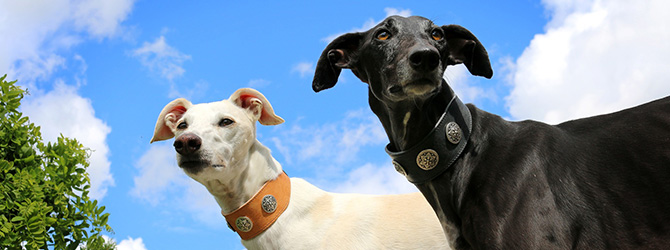The Greyhound: thinking about getting a Greyhound?
Graceful, elegant and fast as lightning, Greyhounds – with their even temper and independent nature – make for gentle and low-maintenance companions.
Let’s take a closer look at the Greyhound.
Place of origin: The Greyhound we know today originated in the UK
How big do Greyhounds get? 68 – 76cm
How heavy are Greyhounds? 27 – 40kg
Life Expectancy: 10 – 14 years
Types of Greyhound: Greyhound, Italian Greyhound
Colour: White, Brindle, Fawn, Black, Red, Blue
Please note: A dog’s exercise, training/stimulation and grooming requirements can depend on several factors such as age and health. The same goes for ongoing costs of ownership. For advice on one specific dog, we always advise chatting with a vet.
How much exercise does a Greyhound need?
Contrary to what you might think, Greyhounds are relatively low-energy dogs and love nothing more than a good nap. To avoid boredom and potentially destructive behaviour though, your Greyhound will need at least one sizeable walk per day.
Channel their sighthound instincts by playing fetch when you’re out and about. When walking through populated areas, it’s a good idea to keep your Greyhound on the lead – if they see anything they might mistake for prey, the can become easily distracted and may wander off a little too far.
Training: how to train a Greyhound
Greyhounds tend to learn the basics quickly enough but their independent nature means they’re not natural tricksters. If you’re looking for a furry friend that can keep themselves entertained and doesn’t need too much one-on-one time, a Greyhound might be the breed for you!
Begin training at a young age and be sure to use positive reinforcement and reward-based training with your Greyhound. They can appear stubborn at times but if you’re patient, they’ll be housetrained in no time.

Grooming: do Greyhounds shed?
To keep your Greyhound’s coat (and your carpet) in good condition, you’ll need to brush your pet daily – they’ll love it!
Complete your Greyhound’s grooming routine with regular tooth brushing, nail clips and ear checks.
Greyhound temperament, socialising and ideal home environment
Greyhounds tend to be soft-natured pets and make for loving companions. They may be wary of new people, particularly children; you can help your Greyhound to become well socialised by introducing them to new friends, sights and smells from a very young age.
Greyhounds are usually fine with other pets. They may mistake smaller pets for prey but again, this is nothing a little training can’t fix.
If you’re seeking a loyal and even-tempered companion who’ll bond well with older children and be happy in their own company (some of the time, at least), a Greyhound may be the perfect companion for you!
Cost of owning a Greyhound
When considering the lifetime cost of owning a Greyhound, remember to take into account:
- Breed-specific food
- Veterinary care
- Pet insurance
- Kennels or dog sitters
- Regular grooming costs
- Toys and equipment
- Preventative healthcare
As a rough guide, allow between £80 and £120 a month to cover the ongoing costs of owning a Greyhound. Our vets have drawn up this handy guide to save dog owners money.
Need more info?
For more info on finding the best dog breed for you and your lifestyle, have a chat with your vet.
Find your nearest vet using our Find a Vet page, or speak to a vet online using Online Vets.

